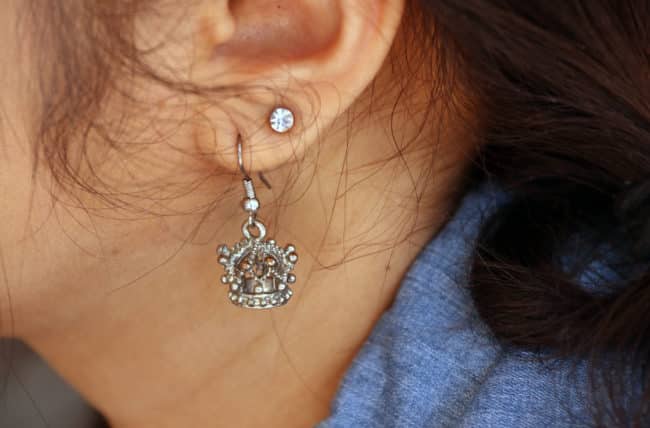
If you stick a nickel-plated needle through your skin, what happens is essentially that your body senses the intrusion and opens up the capillary walls in the surrounding area to let plasma and antibodies in to kill any bacteria and start repairing the damage.
Now, since you used proper sterile piercing procedure, there are no bacteria but some of the nitrogen compounds in these fluids will dissolve nickel from the surface of the needle and react with it. This is the danger, because the nickel that gets “bound” to the cells may change their composition sufficiently that your immune defense system will decide that they’re no longer “you” and hence they’re an infection and need to be fought. If this happens, the tissues swell up more, becoming a regular inflammation and even more liquid stuff is sent in to fight the “nasties”. Unfortunately, they will just dissolve more nickel and increase the problem.
The term “nickel allergy” is, strictly speaking, a misnomer since the problem is more of a hypersensitivity. Your immune defense system is simply doing its job. It’s just a bit “overzealous”. Nevertheless, the problem is real and can become very acute. Once the “allergy” is triggered, the sufferer will react too much lower concentrations of nickel than before. Jewellery that was previously safe may become useless. Some will react to the nickel in coins, railings, cutlery and other household items as it gets dissolved by their perspiration and permeates into the skin. Not to mention the nickel that can dissolve from stainless steel sinks into the dishwater and further into the skin of any person sticking his/her hands into the water. So what can you do? First and foremost you must avoid nickel in jewellery that’s inserted in fresh piercings or in moist places.
The issue is not so much if there is nickel in a certain alloy. What matters is that it STAY there. Gold, for example, has a tendency to “bind” nickel so that down to 18 K a small amount of nickel is usually “safe”, except for “white” gold which often contains (and releases) too much nickel. When you get down to 14 K, the nickel released is often getting dangerously high, at least to those who are already sensitized. Stainless steels frequently contain nickel. The “hypoallergenic” varieties are frequently simply those that “bind” their nickel so thoroughly that little or none of it is released.
In extreme cases the sufferer can find even the most pure metals impossible to wear. Even 24 K gold (nominally 100%) can contain traces of nickel or other contaminations, but this is extremely rare. Most find a marked improvement in simply going from 14 K to 18 K. Other metals are now finding their way into the jewellery business, titanium and niobium rapidly gaining a well-deserved reputation for safety. The oxide layers on their surfaces are sufficient barriers against corrosion and wear and they also do not have nickel’s tendency to bind into the cells of the body and trigger the immune defense system. Otherwise, inert plastics (Nylon, Teflon) work well. Some have reported successful experiments with “alien” organic objects like wood, ivory or porcupine quills which don’t contain anything that can dissolve into the body, but care should be taken with these since they can trigger your immune defense system in their own right, being (formerly) “living” materials themselves.
